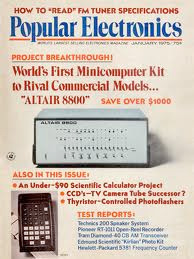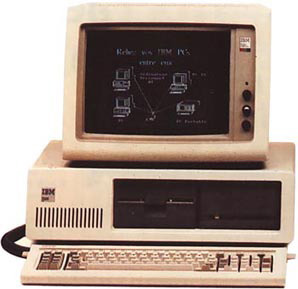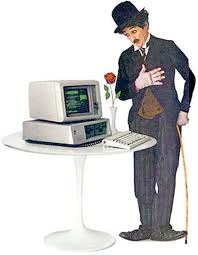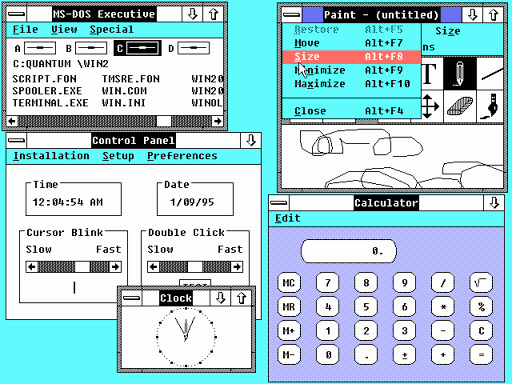Chapter 16: The GUI and the personal computer
16.3 The IBM PC and Unix

The IBM PC was introduced in 1981, impacting the business world in ways that were dramatic. First, it caused other companies, including Apple, to take a new look at how the computer and the GUI could have an impact even beyond the personal computing arena. The PC ultimately impacted many of the decisions that resulted in the introduction of the Macintosh.

In the mid 1970s the IBM company was split into independent business units, including one called the Entry Level Systems (ELS) group. They were responsible for the design of new machines that would advance the IBM brand, within the “affordable” market. The group introduced the IBM 5100 Desktop Portable in 1975 and the 5120 in 1980. These platforms were used as data collection and analysis systems for small labs, and the 5100 had an integrated CRT, keyboard, and tape drive. It was capable of emulating IBM mainframe software. The 5120 was a larger, more expandable version of the 5100.

Intel introduced the first commercial microprocessor in 1971, the Intel 4004, and a few years later introduce the 8008. Altair used the microprocessor in its hobbyist-focused Altair 8800, released in 1975. At the same time, software markets started to open up, thanks to programmers at companies like Digital Research, which sold the CP/M operating system and several programming languages.
The success of the Altair got IBM executives and other computer companies thinking about how they could play in this evolving market. IBM in particular started plans for introducing an IBM microcomputer aimed towards small businesses and consumers. They designed a prototype, based on the Intel 8088 16-bit processor. The software development team for the prototype wanted to make certain that appropriate and necessary operating systems, compilers and software could be available in a timely fashion, so they looked to outsourcing the development. Enter the independent company Microsoft, the market leader in programming languages. Using emulation software running on a DEC minicomputer, Microsoft ported its version of BASIC to the 8088. The project, codenamed Project Chess, presented the prototype, internally called Acorn, to IBM management, showing it running CP/M and using the newly created MBASIC.
Because of disagreements between IBM and the CP/M team, IBM chose to develop a different OS, so they again contacted Microsoft to develop an OS and programming language for Acorn.

The new PC computer, which the marketing staff wanted to price at $1,565, required a different approach to marketing than the approach normally taken by IBM for their larger and more costly machines. It was to be sold to individuals, and IBM wanted to use consumer electronics stores and department stores to sell the new computer, bypassing the normal IBM sales staff.

The marketing campaign used Charlie Chaplin, and was very effective in reaching the desired customer base. The Acorn was renamed the IBM PC 5150, or IBM PC.
In the meantime, the Microsoft partnership was beginning to take shape. Microsoft bought an operating system called QDOS (for quick and dirty operating system) that ran on the 8088 processor from programmer Tim Patterson, who had previously developed it as a port of CP/M. IBM agreed to use QDOS, but renamed it PC-DOS, and let Microsoft market its own version, which they called MS-DOS, leading to the creation of a clone industry a few years later. If MS-DOS hadn’t been freely available, there wouldn’t have been a huge market of commodity computers that were capable of running Windows. In short, Microsoft really owes its entire success to the IBM PC and the PC clones.
In addition to PC-DOS, the programs VisiCalc and EasyWriter were bundled with the PC, although the first version of EastWriter was not very dependable.
IBM’s sales went beyond expectations the first two years, as they sold nearly 3/4 of a million units, tripling the marketing goals.
The IBM PC was more popular with businesses than the Mac, even though it didn’t have a GUI. Bill Gates and Microsoft began developing useful applications for the Mac which helped increase sales. Microsoft’s early partnership with Apple allowed them access to the Mac OS which led to the development of their own GUI, Windows 1.0. Microsoft saw the Mac OS as a threat to their non-graphical operating systems for IBM PCs, MS DOS and knew that they had to develop a GUI to compete.
Steve Jobs had quoted a saying of Picasso that “good artists borrow, but great artists steal” in describing what the Macintosh had gotten from Xerox PARC. Microsoft might say the same about what they got from Apple. In November of 1985, Microsoft’s Bill Gates showed Windows at COMDEX. Windows appeared to copy many of the same metaphors and icons as the Mac GUI with just the names changed, for example the Trash Can in Mac, became the Recycle Bin in Windows (and later the Dumpster in X-Windows for SGI Workstations).

Apple objected and threatened to sue Microsoft, and Gates became very angry over the threat. Ultimately the two companies came to an agreement, and Apple agreed to license the Macintosh’s “visual displays” to Microsoft to use in software derived from Windows 1.0. Microsoft agreed to continue developing its Mac products. They also proceeded to develop Windows 2.0, which they released in November of 1987.
Apple’s executives felt that this version was a breach of the contract that was signed earlier, given how much Windows 2.0 resembled the Macintosh GUI. Apple filed suit against Microsoft in federal court on March 17, 1988 for violating Apple’s copyright, and Microsoft countersued. However, the judge in the case ruled in Microsoft’s favor that most of the contested violations were not in fact violations of Apple’s copyright due to the fact that ideas cannot be protected by copyright.
The relationship between the companies was strained for decades, as Apple appealed the ruling. The case made it all the way to the Supreme Court, which declined to hear the arguments. Online author Tom Hornby has an excellent series of articles on the Mac/PC history, including the Apple/Microsoft lawsuit at http://lowendmac.com/orchard/06/apple-vs-microsoft.html
Windows became more popular not because it was better than the Mac OS, but because it was more open, and could run on millions of IBM PCs and Mac Clones. Apple never licensed the Mac OS to clone makers except for a brief period in the mid 1990s. This caused Apple to lose market share, but kept the quality of their product more consistent than with IBM clones. Windows had flaws because it was built on top of the non-GUI MS-DOS, and it would behave differently on each type of PC clone.
In 1986 Steve Jobs left Apple after disagreements with the board of directors and founded a new company called NeXT which would develop NeXTStep, a GUI for it’s Unix based workstations in 1988. This became the first GUI to simulate a three-dimensional screen. Later when Steve Jobs returned to Apple, NeXTStep would merge with the Mac OS to create Mac Os X.
Around the same time as NeXTStep, in the late 1980s, other Unix workstation manufactures wanted a piece of the GUI action. In 1987 the X Windows System for Unix workstations became widely available. Around 1989 several Unix-based GUIs were introduced. These included Open Look, by AT&T and Sun Microsystems, and Motif for the Open Software Foundation by DEC and Hewlett-Packard. Motif’s appearance is based on IBM’s Presentation Manager, a rival GUI to MS Windows.
